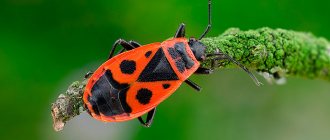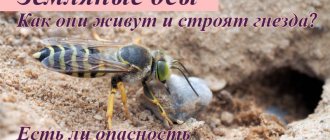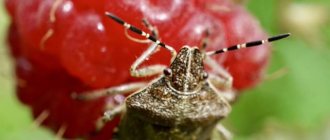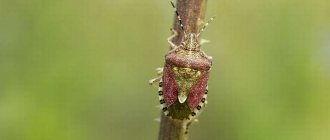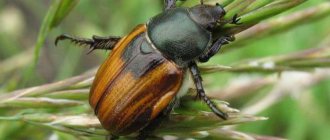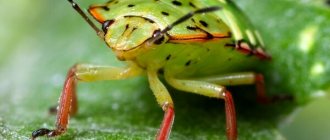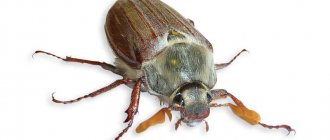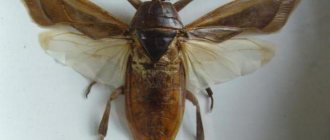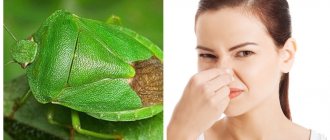The bedbug (lat. Cimex Lectularius) is a type of bedbug, an obligate synanthropic blood-sucking insect, an ectoparasite of humans and warm-blooded animals, feeding only on blood. It is called “bed” because its favorite habitat is the human bed. The second unofficial name for these parasites is “room bugs”; They are called so because of their direct dependence on a person and his home. Belongs to a type of arthropod from the class of insects, the order Hemiptera, they cannot fly.
Let's consider the characteristics of bedbugs, their lifestyle and impact on humans, as well as methods of combating this domestic parasite.
What does a bed bug look like?
The appearance of a bedbug is characterized primarily by a flattened body, which helps it get between fabric folds without the risk of being crushed by a person. The length of the bug is from 3 to 8.5 mm, depending on gender and blood saturation; females are larger in size than males. Body color ranges from dark brown to dirty beige and even rusty.
In addition to the proboscis for piercing the skin, the bug has sharp bristles for secreting anesthetic saliva into the bite site.
Photo of a bug under a microscope. A proboscis emerges from the front of the head to pump out blood.
Bedbugs are most active at night, especially when they are hungry. A well-fed bedbug increases in size, becomes less agile and more vulnerable; it is the well-fed, crushed bedbugs that leave blood marks on the pillowcase.
Traces of blood may remain on the pillowcase if you crush a well-fed bug in a dream.
Description of pests
Bed bugs look different depending on which family they belong to. There are both minimally sized individuals (no more than 1 mm) and huge water bugs (about 15 cm in length). Such a huge insect can even swallow a salamander if it is smaller than the bug itself.
REFERENCE! The body shape of bedbugs is usually flat. When they are saturated with blood, their body begins to round. The bugs that exist in the desert are more like a ball. Other types of insects are shaped like small turtles.
Different types of bedbugs also differ in the presence of wings. Not all individuals can fly. For example, stink bugs can travel great distances. Bed bugs cannot move through the air because they do not have wings.
Types of bedbugs
The most common bed bugs are bed bugs (linen, furniture, clothes). They are called differently, but they always talk about the same bed bugs. There are other types of bed bugs, which are the most popular, but first, more about bed bugs.
- Bed bugs (brown) - do not have wings. Females have a more elongated body, while males have a spherical body. In one bite, a bug of this species drinks 7 ml of blood. The blood of children is preferred over that of adults because they have more delicate skin. They can bite not only people, but also animals and birds. They go hunting at night, from midnight to early morning, and sleep during the day. These bugs do not carry infectious agents.
- Triatomine bugs are black in color and have a body length of up to 2 mm. They differ in that they bite a person in the facial area (lips and eyes). These bugs carry Chagas disease, which is fatal to humans. They are saturated with human blood in 15 minutes. Triatomine bugs can be found in South America. A blister appears at the site of the bite.
- White bug - usually found in apartments, but there are much fewer of them than in bed bugs. They have white hairs on their heads, which is how they got their name. More often they bite bats, feeding on their blood.
- Alfalfa bugs are also called weevils. They feed on legumes and are agricultural pests.
Features of the life of bedbugs
Bed bugs are the realest long-lived insects among other insects. Adult representatives of this species can live up to 15 months. If the bug does not have food (blood), then they are able to fall into suspended animation. When food appears, the bug becomes active again. These insects cannot be controlled by temperature. Heat will not harm them, nor will frost down to -200C.
REFERENCE! Bedbugs die at a temperature of -500C, and not instantly, but within several hours. At a temperature of +500C or more, they will also slowly die.
Interestingly, different forms of development have different survivability.
- Eggs are more durable because they have a dense shell. They survive at temperatures from -30 to +550C.
- The larvae die in the heat within a few hours, and in the cold within a few days. Their survival temperature is from -25 to +500C.
- Adults die instantly in the heat, and within a few days in the cold. Temperature from -20 to +500С.
REFERENCE! It is impossible to freeze bedbugs at home, but you can heat them. A steam generator will help with this and will kill the parasites.
Why do bedbugs appear in an apartment?
Bed bugs can eat a wide variety of foods, depending on the species. But most often in the apartment there are those that feed on human blood. A characteristic feature of domestic bedbugs is their rapid spread. If bedbugs appear in one apartment in a high-rise building, they will soon appear in all the others.
Where do bedbugs come from indoors?
Bedbugs can live anywhere within an apartment, for example, in the upholstery of a sofa, in a mattress, a wardrobe, behind baseboards, wallpaper, and so on. It doesn’t matter whether the apartment is cleaned or not, the main thing for bedbugs is the availability of food.
Bedbugs can enter an apartment in the following ways:
- Migration on guests' shoes or clothing. People visiting your home may bring insects on their belongings, or you can do it yourself.
- Poor pest control of neighbors. If the neighbors carried out poor-quality baiting, then the entire horde of insects simply moved to the neighboring apartment and did not die.
- A gift from another country or city. Quite often we bring bedbugs into our home from long trips. For example, checking into a hotel with bedbugs that can travel many thousands of kilometers in your suitcase. To spread, it is enough to bring just one female into the house, which in a few weeks will turn into a whole horde of bedbugs.
- From livestock. If you live near farms with small livestock or poultry farms, then there is a high probability of bedbugs in your home. These insects prefer human blood rather than animal blood.
- After a hike in the forest, you can bring home forest bugs.
- When buying furniture, you need to be very careful, as there is a risk of purchasing one that is infested with bedbugs.
Bed bug lifestyle
The bug leads a parasitic nocturnal lifestyle; both females and males with larvae feed on blood. The main time for an attack on a sleeping person is from 3 to 8 am. During the day, these insects hide in the mattress, under the wallpaper, behind the baseboards, in books, in clothes and beds. During the day they come out into the light extremely rarely, only in case of severe hunger. They are able to move from one room to another through ventilation systems, as well as along walls both inside and outside the apartment. The speed at which an adult bedbug travels 1 meter is 1 minute.
Bedbugs have a well-developed sense of smell, which helps them find victims and places of shelter. For example, they can smell the clothes you wear most often, such as a dressing gown, and hide in it.
What do bed bugs eat?
Bed bugs feed exclusively on blood. They do not need water and food to live, like cockroaches. Not only females drink blood (like mosquitoes), but also males with larvae.
An adult can drink up to 7 mg of blood at a time, and a larva can drink less than 1 mg. Parasites feed approximately once a week. If a person is not nearby, they can bite cats, dogs, rodents and even birds.
How long do bed bugs live?
The average lifespan of a bed bug is 1 year. In extreme situations, for example, in the event of a sudden cold snap or a person leaving the apartment for a long time, they can fall into a state of hibernation and spend more than a year in it.
At what temperature do bedbugs die?
Temperature at which bedbugs and their clutches die: +50˚С (temperature must be maintained for at least 10 minutes).
Negative temperature at which a colony of bedbugs dies along with their eggs: -25˚С (the temperature must be maintained for at least 2 hours). Frost down to -10˚C is practically not scary for bedbugs; they simply hibernate.
Comfortable temperature for bed bugs to live and reproduce: +20-30˚С. This is the temperature maintained in apartments and private houses.
How do bedbugs live, when and what do they eat?
Bed bugs are nocturnal. During the day they hide in their nests located in secluded places in the apartment. At night, parasites crawl out of their hiding places to drink blood. Night is the best time to search for food. While a person is sleeping, it is easy to approach him and choose the most tender part of the body to bite.
It takes 4-10 minutes for a bedbug to get enough. During this time he can make about 10 bites. The body of a well-fed parasite lengthens to 8–9 mm and becomes convex. Adults “go hunting” once every 5–6 days. Nymphs need food more often: they suck blood every day. Without it, the larvae go into suspended animation. They can stay in this state for up to 1.5 years.
Saturation of the bug with blood for 10 minutes
Bedbugs have a developed sense of smell. They sense the air exhaled by a person at a distance of 3 m from him. Pests can feel its warmth at a distance of 1 m. In 1 minute, bedbugs cover about 100 cm. But, having drunk blood, they become slow and clumsy. At this time, they are especially vulnerable: they can easily be crushed in their sleep, turning over from one side to the other. Therefore, after waking up, you can find crushed individuals and blood stains in your bed.
Reproduction and development of bed bugs
Mating of bedbugs occurs through traumatic insemination: the male pierces the female’s abdomen with his genitals and injects seminal fluid there. After a couple of weeks, the female begins to lay eggs, up to 5 eggs per day. Over the course of her life, a female can lay 250 to 500 eggs.
The development of an insect from an egg to the adult stage takes 30-40 days, and under difficult conditions (for example, at low temperatures) up to 100 days. The larvae immediately begin to look for food, they need to drink a whole portion of blood in order to move to the next stage of development and undergo molting.
Habitat
Cimex adjunctus is found mainly in North America. As is correct, the most favorite habitat of white bedbugs is the attic. Because this is where you can find their main food donor - bats. Recently, white bugs have begun to appear in ordinary apartments . Their main location is around the cornices, cabinet crevices and upholstered furniture. However, the degree of cleanliness of the owners does not in any way affect the quantitative component of bedbugs, due to the fact that the main criterion for choosing a place of residence for these insects is the presence or absence of food.
What does it eat?
The white bug is an ectoparasite that feeds on blood; between meals it leaves the host's body until its next feeding. The main source of food for Cimex adjunctus is insectivorous bat species. However, in some situations this parasite can feed on human blood.
Differences between bedbugs and other insects in the house
Male bedbugs also feed on blood, although in some insect species only females feed on blood in order to be able to reproduce.
Bed bugs are often confused by name with bed dust mites. Dust mites are very small and cannot bite through human skin; they live in pillows and other parts of furniture. They feed on microscopic particles of skin that fall off our bodies. It is unlikely that you will be able to see a dust mite with the naked eye, but it still causes harm: a person can develop an allergy from its waste products, which is confirmed by tests, and this is what is written in the diagnosis “dust mite allergy.”
Dust mite under a microscope
Unlike ants, bedbugs do not build nests and do not form colonies; they prefer to randomly accumulate near a food source, usually near the place where a warm-blooded living creature spends the night. Ants do not feed on human blood, but can only bite in defense.
Unlike fleas, bedbugs are larger in size and cannot jump. Traces of their vital activity are easier to detect than to understand that there are fleas in the apartment. Scars from flea bites most often appear on the legs, in contrast to marks from bedbugs, which can also cover the upper body.
Why do bedbugs appear?
By and large, the answer to the question in the title sounds extremely simple. Bedbugs appear in an apartment or private house if only two conditions are met. The first is to get at least one female inside the dwelling. The second is the presence of a food base, that is, humans or domestic animals.
There are simply no other options for answering the question of why bedbugs appeared in the apartment. For example, violation of sanitary standards is not the reason for such developments. Parasites cannot appear out of nowhere. Any settlement of a human home requires the initial appearance of at least one individual in one of the ways described above.
How to determine that there are bedbugs in an apartment?
It is not difficult to determine the presence of bedbugs in a private house, apartment or dorm room; pay attention to the following signs of their presence:
- Black dots on the mattress, sheets, under the pillow - dark-colored bedbug feces that look like traces of a black pen or felt-tip pen. Make a light bed, this will make it easier for you to detect the presence of parasites, and the traces will be washed off.
- Eggs, full or empty, as well as fragments of the shell of the bedbug larva, which it sheds, moving to the next stage of development.
- Traces of multiple bites on the body. The bug bites not just once, but several times, so many bites will be noticeable on one area of the skin. You are unlikely to be able to feel the moment of the bite, because the bug injects a “painkiller” under the skin.
- A visual inspection of the bed at night will show whether there are bloodsuckers in it. Set your alarm for 5am, get up, turn on the lights, and examine your bedding.
Where do bedbugs come from?
Blood-sucking parasites enter the house through gaps and cracks in the walls or floor, and can enter the apartment through ventilation grilles and windows, cracks under the entrance doors. If the inhabitants of a neighboring apartment change their place of residence, the insects crawl into other rooms where there are people. You can bring a bedbug in a suitcase from a long trip, or bring it on your body or clothes after a walk in the forest. The eggs of blood-sucking insects enter the house on the fur of pets.
Cluttered utility rooms - attics, attics and basements - become habitats for parasites. They can get there along with old things from flea markets (clothes and shoes), corrugated cardboard and paper packaging, actively multiplying in old newspapers and magazines.
Causes of bedbugs in the house
Many people think that bedbugs only grow in dirty, unkempt rooms, but this is not true. They are able to take root in any room, regardless of the sanitary situation. Where do they come from? List of main reasons:
- from neighbors who allowed unsanitary conditions in the apartment;
- from pets walking on the street;
- from a hotel or hostel, they can come home with you in a suitcase with clothes;
- from used furniture or equipment, purchased on Avito or brought from the trash.
Interestingly, bedbugs cannot independently move along the street from one private house to another. Therefore, if bedbugs have appeared in a private home, be sure that you brought them yourself on some things, furniture or clothing.
Is it possible to protect your home?
100% ways to protect homes from bedbugs have not yet been invented. They can enter the apartment through the hood or through cracks in the slabs. Of course, you can secure the ventilation grilles by covering them with a thick mesh and sealing the cracks. But no one is immune from “picking up” a bedbug in a hotel, public transport, or while visiting.
The only thing that can be protected is the bed and mattress. This can be done by using special traps and a protective cover of the HECTOR brand.
The traps have a rough outer surface that abruptly turns into a groove with smooth walls. Each of the bed legs should stand inside such a trap. Since bed bugs are insects that can only crawl, the only way into your bed is through the legs of the bed.
Protective mattress cover Hector It is a completely sealed cover with a micro-zipper. By putting it on the mattress, you will not allow bed bugs to settle inside, which means you will save it in case the apartment is infested with insects. The cover consists of two layers. The inner and most important one is made of a special membrane, ensuring 100% tightness, and the outer one is made of 100% cotton. It is important to note that the membrane of the inner layer breathes well and does not creak.
Also, if your sleeping place is already infested with insects, you can save the mattress, since by wearing such a cover, the bed bugs that are already inside will be “walled up” and they will not have access to food.
Why do bedbugs appear in an apartment?
Like any parasite, the bug moves in search of food. What attracts a person to a home is not the dirty and unkempt environment, but the opportunity to obtain a constant and valuable source of nutrition. Therefore, disorder and an unscrupulous owner are not the root cause of bedbugs. Even clean apartments become a tasty morsel for parasites.
Bedbugs can get into the house in several ways:
- From animal pens. In rural areas, bedbugs infest in barns, chicken coops, and pigsties and gradually move closer to humans.
- From the neighbors. Bedbugs can move between apartments and houses in search of more favorable living conditions.
- From trips. Travel lovers can easily bring a new tenant with them in their suitcase. Most often, bedbugs can migrate from countries with warm climates.
- From a furniture store. Not only used, but also new furniture can become a source of bedbugs in the apartment. Pests love to crawl into the folds of upholstered furniture or into the cracks of cabinets.
- From a clothing store. Bed bugs live in items of clothing that we try on in stores and then successfully bring home. Most often this happens after visiting drains or second-hand stores.
- From a hardware store. When we buy a computer or TV, we can also buy a new neighbor who is hiding in boxes or in the equipment itself.
- From libraries and bookstores. Bedbugs also know a lot about books, so they choose them as a place of residence, eventually moving into human housing.
- With animals. Sometimes pets themselves become carriers of bedbugs, which can get caught in their fur while walking.
If we do not notice small pests, this does not mean that they do not exist. Bedbugs live not only in people’s personal apartments, but also in public places - clinics, offices, warehouses, shops.
How can you tell if there are bedbugs at home?
Night life and small size have made the bug practically invisible. It is extremely difficult to detect the appearance of the parasite, especially during the daytime.
You can understand that dangerous neighbors have settled next to you based on several signs:
- Unpleasant smell. The release of an unpleasant odor is a useful property of bedbugs, which helps them scare off the enemy, and helps humans recognize the appearance of parasites in the apartment. One bug is unlikely to create a stink in your home, but as the pests multiply, the smell of rotten nuts or berries will begin to appear in the house.
- Black dots. Pests leave behind small black dots - excrement.
- Scales and eggs. After molting, bedbugs shed their scales, and sometimes translucent, oval insect eggs can be seen. Finding them is not so easy, since females lay them in dark, hard-to-reach places.
- Marks on furniture and bed linen. When a bug “gets full” and becomes clumsy, it is very easy for a person to crush it in his sleep, which can cause drops of blood to appear on the bed.
- Bites on the body. The surest way to understand that there are bedbugs in your home is to examine your body for red bite marks. They appear after night in the form of red spots with a diameter of 15 mm, usually located close to each other. Bedbugs bite in areas with the thinnest skin - the neck, face, arms, buttocks, back.
To know how to get rid of bed bugs in an apartment, you need to identify the source of their reproduction. For searching, it is better to arm yourself with a flashlight and a magnifying glass, thanks to which you can find barely visible eggs, larvae or other traces even in the most inaccessible places.
Harm from bed bugs to humans and animals
In addition to irritation and redness of the skin, inflammation may also appear at the sites of bedbug bites if an infection occurs during resorption. Multiple bedbug bites can lead to the development of an allergic reaction and the appearance of a rash, as a result of which the affected skin will be very itchy and interfere with a full life.
There is an opinion that bedbugs carry dangerous diseases such as typhoid, smallpox, and hepatitis. But the facts of infection have not been proven.
For pets, severe harm from bedbugs is also unlikely; bald spots may appear due to the pet scratching the bite site.
The harm that bedbugs can cause to humans
Bedbugs can carry various infections. This is of course not proven! But you should be careful! They can transmit organisms that cause diseases such as tularemia, smallpox, hepatitis B, tuberculosis, typhoid fever and anthrax.
They cause great harm to people with their bites, depriving them of rest and sleep, thereby reducing their performance! They are traumatic and have a negative effect on the human psyche. In some cases, bites cause skin rashes and allergies. While feeding, the bug makes more than one bite! As the bug moves, it makes many bites; if the room is heavily infested, there can be 600 or more such bites in one night!
It has been proven that 70% of people fail to notice bedbug bites anyway, making bedbug detection difficult. They are detected by brown marks on the bed, formed when a bedbug is crushed by a person tossing and turning in his sleep, who is bothered by the bites. If a room is significantly infested with bedbugs, a specific smell reminiscent of cognac may appear! For some it may be the smell of mold, mustiness!
Sometimes, after treatment for bedbugs, dry cleaning of furniture may be required to completely eliminate unpleasant odors and traces of their activity.
Thanks to their sense of smell, bedbugs detect a person’s everyday clothing (usually synthetic) and hide in it, thus moving to other homes. Also, bedbugs can hide and lay eggs in any electronic equipment and pet fur, in paintings, books, and boxes. Basically, bedbugs really love wood!
Symptoms of bed bug bites
The symptoms are individual for everyone: some do not notice them until they see red dots on the body, while others begin to experience severe discomfort due to itching. Unlike a mosquito bite, the mark of a bug remains longer and is distinguished by bright redness with characteristic compaction and swelling.
You can only feel the moment of the bite if the larva is biting, because it has already developed an anesthetic secretion.
In another article, we described in detail how bedbugs bite. The link will open in a new tab.
If the skin is very swollen and the redness has spread far beyond the damage, then you are allergic to bedbug bites. The following symptoms may appear:
- general weakness in the body;
- nausea, vomiting;
- dizziness;
- muscle spasms;
- lack of air.
If you have these symptoms, immediately take an antihistamine and consult a doctor!
If there are no allergies or complications, it will be enough to disinfect the damage with alcohol or soda solution and apply Fenistil or other gel with a healing and soothing effect.
The Gektor company has released a special gel to eliminate marks from bedbug bites. Gel Hector consists of natural ingredients and helps relieve inflammation and prevents scratching of damaged skin. The disinfecting properties of the drug help speed up the healing of wounds, and the nutrients return the skin to a healthy color. A 50 ml tube costs about 230 rubles.
Destruction of bedbugs
Getting rid of bedbugs on your own is quite difficult. If you use freezing for this purpose, turning off the batteries in the apartment, you can cause serious damage to the heating system. If you use a heat gun that can destroy bedbugs, you can get an effect, but it can be found in few places. Household steam generators, as well as powders and sprays, act locally and therefore temporarily.
Information alone about where bedbugs come from in our homes is not enough. You also need to understand how you can destroy them. And this can only be done with the help of professional treatment of all apartments in the entrance, and even better - throughout the entire house. After the specialists carry out the treatment, you only need to follow the recommendations and clean the apartment, after which you can live peacefully in your home without bedbugs.
Effective modern remedies for bedbugs
To be honest, traditional methods, physical and mechanical effects are practically useless in the fight against bed bugs; they will only rid the house of parasites for a short time and force them to take cover for a while. Traditional recipes and herbs are good only for preventing the appearance of insects, but not for removing them.
Modern drugs are very effective and can destroy bloodsucking bedbugs in one or two applications. The most popular and suitable product on the market now is HECTOR powder.
There are quite a lot of reviews on the Internet from people who have dealt with the problem of bedbugs with Hector. From them it is clear that the product really works, but there are several nuances. Due to its powder form, “dust” may form during processing, and it must take at least two weeks to achieve results.
There is an opinion that the most effective way to get rid of bedbugs in an apartment once and for all is to call a pest control service. But, unfortunately, not all services are conscientious about their work. Many of them are aimed only at obtaining maximum profits, saving on the quality of the funds used. Someone deliberately does not complete the treatment so that the client calls the “specialist” again. Now you can easily cope with insects on your own, since all methods and means are freely available. However, the choice is yours.
It is possible to remove bedbugs, but protecting yourself from their appearance is quite difficult, so be attentive to redness on your body and stains on your bed linen, then you can begin to destroy the parasites at an early stage, when they have not yet had time to breed.
Review of drugs to combat bedbugs
If there are bugs in your apartment, and there are only a few of them, you can try to destroy the parasites yourself. For this, there are many effective insecticides of natural and chemical origin. Let's give a brief description of the most popular means.
Ecokiller
Natural insecticide: does not contain pesticides or poisonous substances. Completely environmentally friendly product. Safe for people and animals. Product contains: 100% diatomite powder (silicon). Has no smell. Does not cause allergic reactions or poisoning.
Principle of action: microparticles of the product fall on the insect’s body, joints or joints. The wax layer is mechanically destroyed, drying out the insect, and water evaporates from the insect’s body. As a result, the insect dies from desiccation.
Instructions for use: treat the bed frame with powder, sprinkle it near the baseboard and in other places where bedbugs have been noticed. After the pests disappear, carry out wet cleaning. The product is safe for people and animals.
- Ecokiller bed bug repellent 150 ml.
₽ 149,00
- Ecokiller for bed bugs 500ml.
₽ 349,00
Karbafos
Karbafos
The drug is a dark brown liquid with a specific persistent odor. The active substance is malathion. It penetrates the external integument of the parasite and is oxidized to toxic maloxon, which has a nerve-paralytic effect. The product is effective against adults, nymphs and eggs. There is a possibility that insects will develop resistance, in which their bodies begin to break down malathion into safe compounds.
Analogues of Karbafos according to the active substance:
- Fufanon;
- Furanone;
- Foscon-55.
Karbofos is low-toxic for warm-blooded animals. Therefore, it can be used in everyday life. The liquid is used to treat detected clusters of parasites. But it cannot be used for upholstered furniture. The smell eats into textiles and does not disappear for months. 2 months after bedbug baiting, carry out general cleaning.
Dichlorvos
Dichlorvos
Dichlorvos is an aerosol with a specific unpleasant odor. Contains organophosphorus compounds that enter the body of parasites through the integument or respiratory tract. They act as a nerve agent. The risk of developing resistance is small. The drug decomposes quickly. The maximum duration of action is 3 days.
Spray the aerosol in the area where insects accumulate. Use it to work out communication routes between apartments. So that a toxic layer remains on the surfaces, each for an area of 1 square meter. m. you need to spray Dichlorvos for 20–30 seconds. It should be handled using personal protective equipment. After spraying, you need to leave the apartment with your pets for 2 hours. You can enter it only after ventilation.
Attention! Dichlorvos is effective only against adults and nymphs. Therefore, a second and third treatment is required at an interval of 10 days to destroy bedbugs that have hatched from eggs.
Hot fog
Hot fog
Hot fog is the name of the method of treating apartments against bedbugs using any insecticide. It consists of spraying the product with a steam generator, which provides a complex effect. The destruction of pests occurs not only by paralyzing their nervous system. They die from high temperatures, which reach 90 ° C.
After treatment with the hot fog method, a toxic cloud consisting of particles up to 10 microns in size hangs in the premises. This is 30 times less than when spraying insecticides using an aerosol can. Therefore, the active substances penetrate into the most inaccessible places, eat into the structure of upholstered furniture and interior decoration and continue to act for several months.
Attention! The hot fog method is the most effective method for controlling bed bugs. But he requires calling the SES.
Xulat Micro
Xulat Micro
Xulat Micro is a concentrated suspension containing:
- cypermethrin;
- tetramethrin;
- piperonyl butoxide.
Substances penetrate into the body of the bug by contact. Thanks to their combined action, they instantly paralyze the nervous system of pests. The drug is not effective against eggs, but its effect lasts for 6 months. Repeated treatment 10 days after the first may be required only if the apartment is heavily infested with bedbugs.
Dilute 5 ml of suspension in one liter of water. Mix the mixture thoroughly and treat all surfaces with it, paying special attention to cracks and other secluded places. Solution consumption - 100 ml/sq. m. The drug has low toxicity for adults, children and pets. Therefore, it is approved for use in children's institutions.
Get Total
Get Total
Get Total is one of the most effective drugs. It is a liquid cream suspension with an orange aroma. Its active ingredient is chlorpyrifos. It penetrates the chitinous shell of the bug and paralyzes the nervous system. The product is effective against adults, larvae and eggs. It remains effective for 6 months.
Dilute 50 ml of product in 1 liter of water. This amount is enough to treat an area of 10 square meters. m. Use the prepared solution within 24 hours. Get Total has low toxicity, so if the instructions are followed, it is safe for people and animals.
Executioner
Executioner Executioner
is a highly toxic drug, including for humans. Effective against nymphs and adults, but does not affect eggs. Therefore, to combat bedbugs in an apartment, double treatment is required with an interval of 10 days. The active substance is fenthion, which has a nerve-paralytic effect on pests.
The insecticide is available in liquid form. To treat an apartment, dilute 6 ml of the drug in 500 ml of water. Shake the mixture thoroughly. This amount is enough for 5 sq. m. When working with the Executioner, the use of personal protective equipment is mandatory.
Other drugs for controlling bedbugs based on fenthion:
- Forsyth;
- Sulfox;
- Bifethrin;
- Biocyfen.
Combat
Combat
This is an aerosol based on imiprotrin, a neurotoxic poison effective against adults and larvae. Does not destroy bedbug eggs, which necessitates secondary treatments. The drug is almost non-toxic to people and animals.
Protect yourself with a respirator and spray the spray where bedbugs have been spotted. With the help of a long and narrow tube, you can treat the space behind the baseboard, cracks in the floor, walls, spaces between furniture and other hard-to-reach places. Then open the windows and leave the apartment for 30 minutes. Take your pets with you.
Raptor
Raptor
To combat bedbugs, Raptor is used in the form of an aerosol based on alphacypermethrin. This substance penetrates the chitinous shell of insects and acts as a neurotoxin. In terms of toxicity to humans, the drug belongs to hazard class III. Therefore, you need to work with it using personal protective equipment. Raptor is ineffective against eggs.
You need to spray the aerosol near the nests formed by bedbugs. It can be used to treat cracks, joints between elements of upholstered furniture, baseboards, carpets and other secluded places. After treatment, leave the room for 30 minutes. Then ventilate it for 2 hours.
Cucaracha
Cucaracha
Cucaracha is a concentrated suspension based on a complex of two neurotoxins: cypermethrin and malathion. Adult bedbugs and nymphs are sensitive to the drug. The product is ineffective against eggs. In terms of toxicity to humans, it belongs to hazard class III (moderately dangerous).
To prepare a working solution, dilute 2.5 g of suspension in one liter of water. Consumption is 45–50 ml per 1 sq. m. surface. When processing hygroscopic materials, it doubles. Repeat treatment after 10 days.
Insecticide
Insecticide
Insecticide is a three-component aerosol based on permethrin, cyperiethrin and piperonyl butoxide. The first two substances are powerful neurotoxins. The last component blocks the production of protective enzymes in the bug's body. Most insects die within half an hour. The product is effective in the fight against bedbugs at all stages of development.
Spray the spray for 10 seconds to cover every square meter of space. Keep the can at a distance of 20 cm from surfaces. Pay special attention to cracks and secluded places. After disinfestation, leave the premises for 5 hours. Then come to open the windows. After two hours of airing, you can return home.
What can a bedbug be confused with?
It would seem that a detailed description of the appearance of a bug makes it easy to distinguish it from any other insects, harmful or not. However, the variability in the appearance of the parasite, which allows for serious variation in both size and body color, often leads to confusion. For example, quite often a well-fed bug can be mistaken for a cockroach. Photos of both insects are posted below, with the bedbug on the left and the cockroach on the right.
The similarity between the two parasites is obvious. They have similar sizes, similar coloration of an elongated segmented body. The main differences lie in several parameters. Firstly, the bug's body looks more rounded. Secondly, it darkens only after feeding. Thirdly, cockroaches are much more mobile and fast than bed bugs, which move at a low speed even in a hungry state, and are generally inactive when well-fed.
Another parasite with which the bedbug is often confused is the linen louse. Confusion often arises when comparing insect larvae. Just look at the photo of a linen lice and compare it with the images above.
To combat different insect pests, various methods and means are used. Therefore, it is extremely important to know what a particular pest, including a bed bug, looks like, and to be able to distinguish them from each other. To do this, you should consider in detail the most important external signs of bedbugs at different stages of their life cycle.
Does it bite?
Like all representatives of the order of bedbugs, the White bug also feeds on the blood of warm-blooded animals and, in some situations, is capable of feeding on human blood. The appearance of this parasite in the house is very difficult not to notice, but there is a high probability of confusing bedbug bites with the bites of other pests. In the morning you will find red dots on your body that are quite itchy and may later become swollen and even inflamed. In the center of the red spot you can see a black dot - this is the mark of an injection made by the bug with its proboscis. In general, bites are usually multiple and can most often be found on the neck, back, shoulders, arms and legs. The bites are located in the form of tracks at a distance of 2-5 centimeters from each other. Red spots can range from several to several dozen. After some time, the itching goes away and the bite marks disappear. However, if a person is allergic to insects, these bites can cause very disastrous consequences.
It is possible and necessary to quickly relieve unpleasant sensations. To do this, you need to apply ice or something cold at hand to the bite site. And after that, be sure to lubricate the wound with an alcohol-containing solution (calendula tincture, ethyl alcohol, etc.). This treatment will prevent infection from entering the wound and help avoid negative consequences.
REFERENCE! If the wound becomes inflamed, it can be lubricated with anti-inflammatory ointments, which are available to everyone, as they can be found in any pharmacy.
Types of bedbugs
Insects differ in color, structure, body shape, and size. Some fascinate with their brightness, beauty, and unusual shapes, while others are invisible; this feature helps them hide in thickets, grass, and on various plants.
Many people often ask how big bedbugs are. It all depends on the type of insect, because certain groups have distinctive features in appearance and body size.
But it’s still worth highlighting the common types of bedbugs:
- blood-sucking species;
- agricultural pests;
- turtle bug;
- stink bug;
- water bugs;
- smooth bug.
Prevention
If there are bedbugs in neighboring apartments, it is necessary to carry out preventive treatment of the entire house with insecticidal preparations:
- For the purpose of preventive measures, you need to carefully inspect all brought furniture. Especially if the furniture was purchased secondhand. It is also recommended to inspect wardrobe items, bags and suitcases. This can keep you away from nasty pests.
- You should not bring home discarded soft toys, which are often the site of large concentrations of bedbugs.
- If you have returned from a trip where you stayed at a hotel, then the first thing you need to do is inspect your travel bag or suitcase and, in case of the slightest suspicion of the presence of “guests,” carry out thermal or chemical treatment of it.
Signs of appearance
It is very easy to determine the moment when white bugs appeared in your apartment; the following characteristic signs immediately indicate this:
- bite sites on the body are usually expressed in multiple numbers, in the form of tracks;
- a characteristic smell that is difficult not to feel (due to the fact that bedbugs have glands from which a special liquid is released to attract individuals of the opposite sex);
- the appearance of waste products (excrement and chitinous remains). Outwardly, they look like black dots in corners, in cracks, under the baseboard. In the apartment they will be quite noticeable;
- You may notice brown spots or blood stains on the bed linen.
